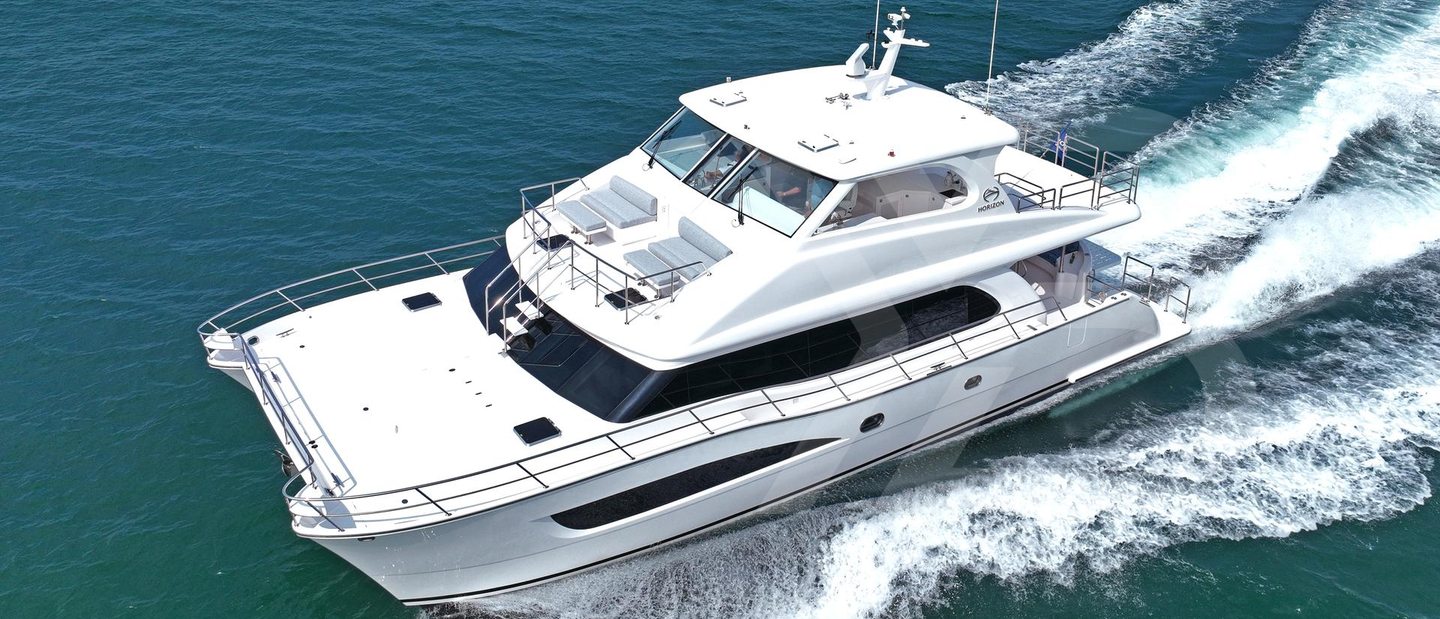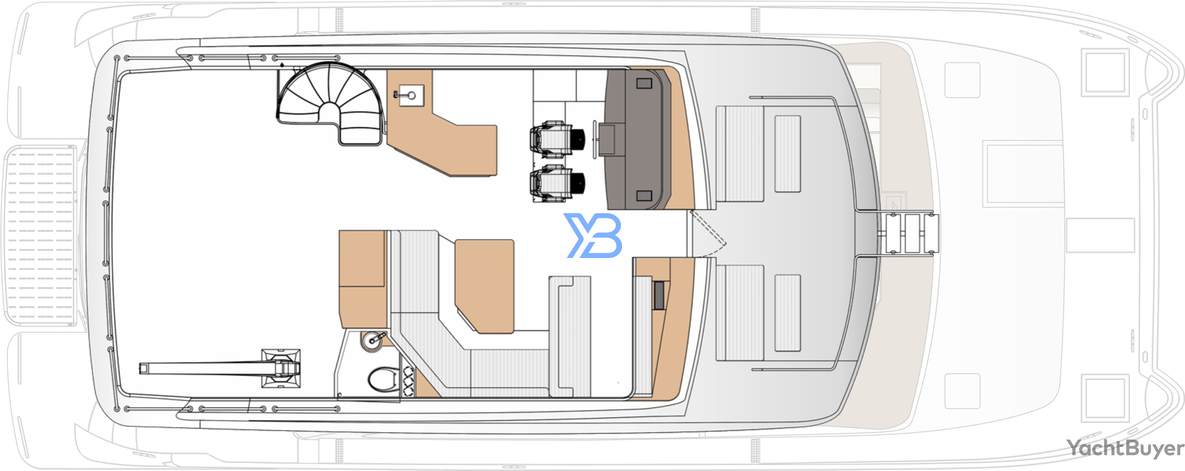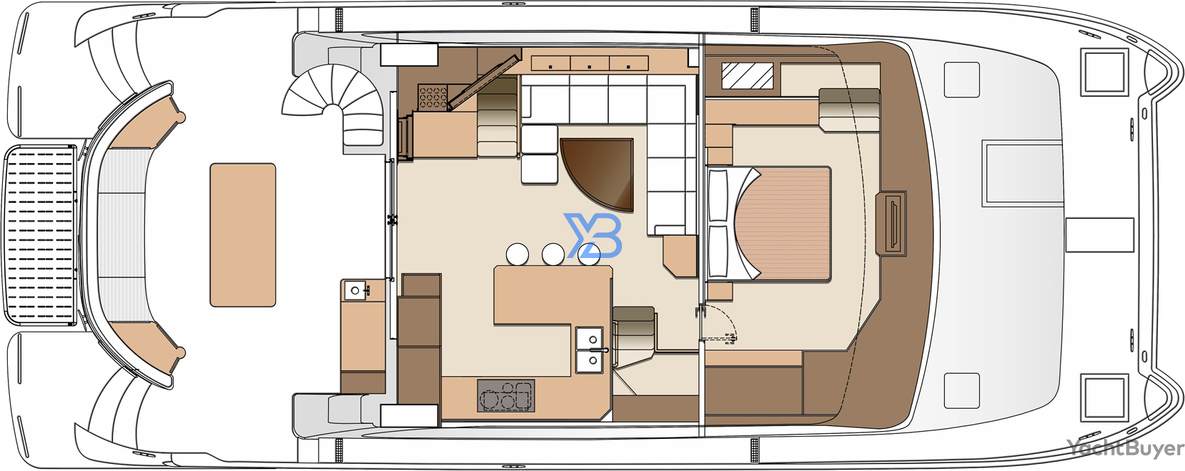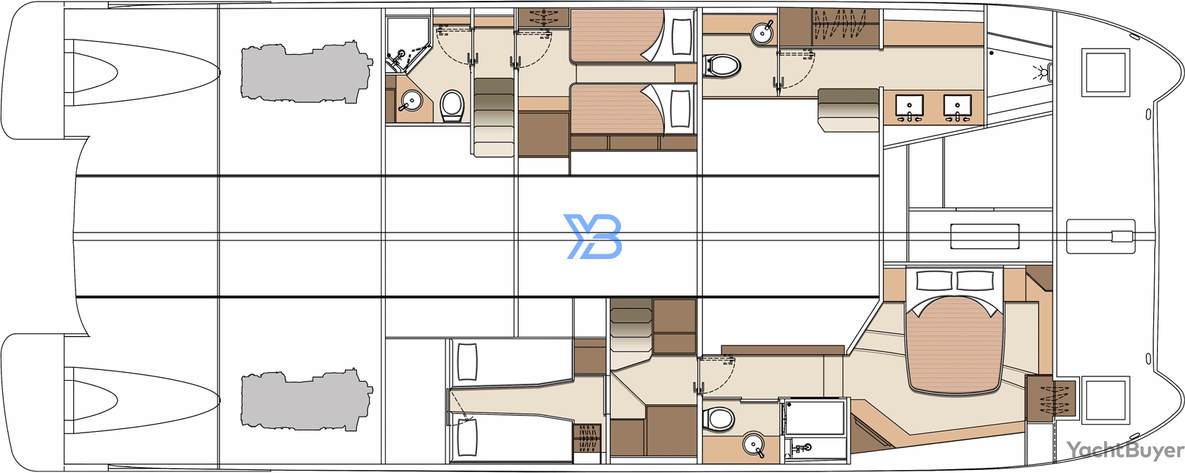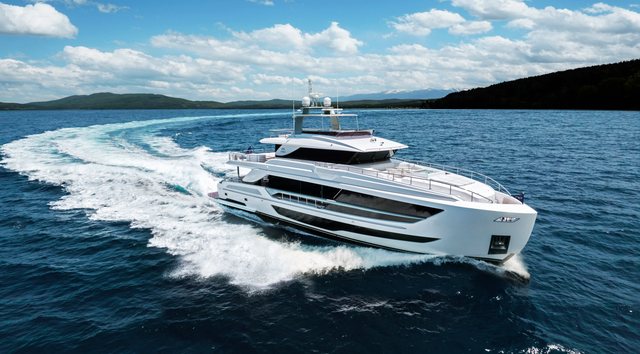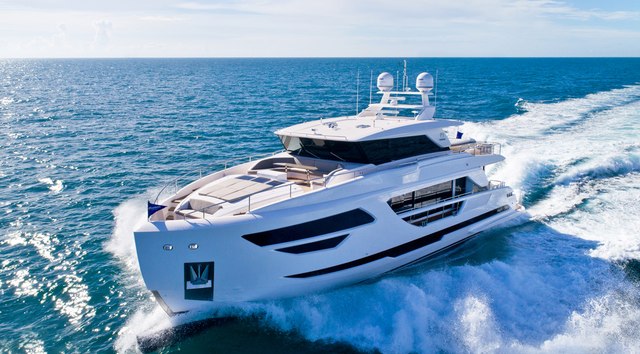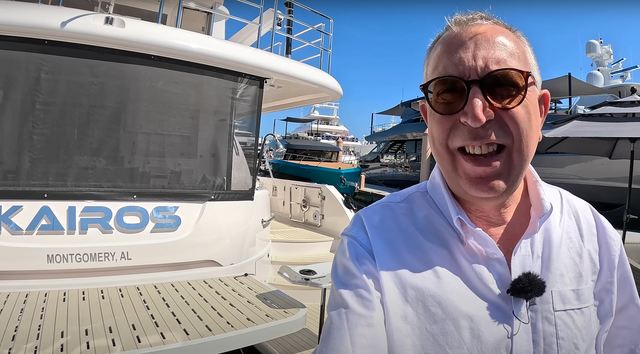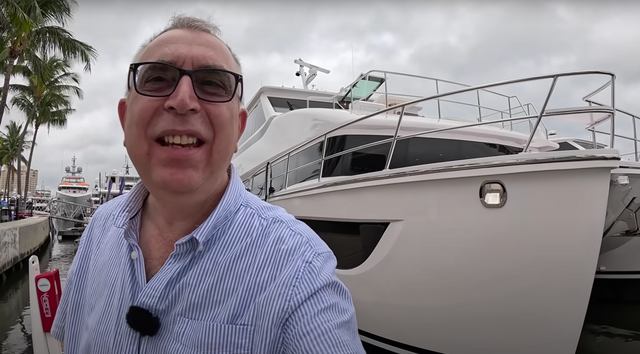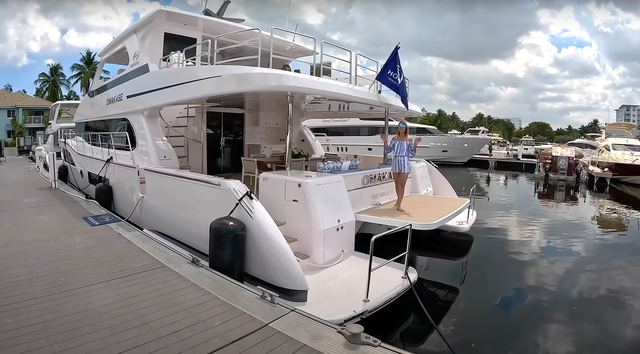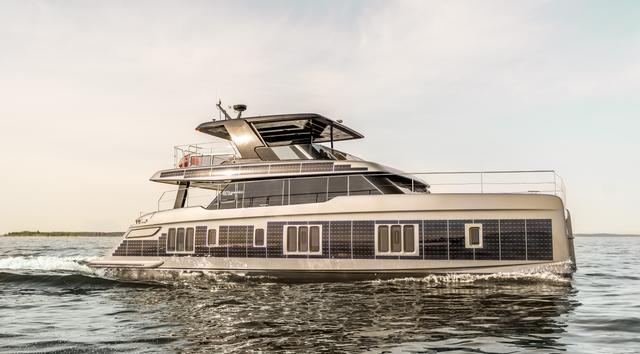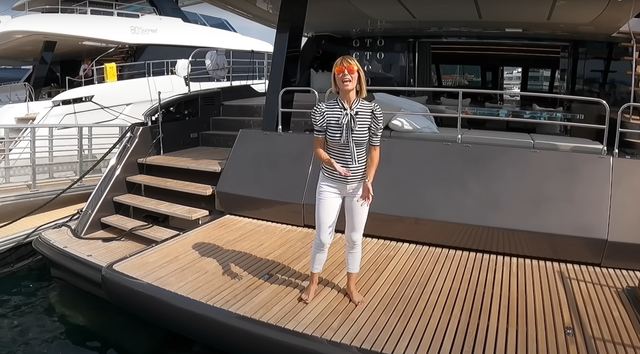Horizon has been building a popular range of powered multihulls long before the current boom in the genre began to take hold, and it's fair to say that the PC60 is one of the most popular powercats ever built.
The addition of a Portuguese bridge may not seem like a groundbreaking piece of design, but it utterly changes the flow of the boat and only for the better. Being able to move between the upper and main deck at the forward end of the boat makes the boat so much easier to live with, and the two benches positioned forward of the helm station could quickly become a favourite spot on the boat for guests to join the ride. The basics are great with plentiful deck storage, three very comfortable guest cabins, and home-away-from-home comforts, but the new design could be the cherry on top. Read on to find out.
Horizon Power Catamarans brings a meaningful update to the PC60 line at the 2025 Palm Beach International Boat Show, showing off a completely reworked top deck layout on hull 32. This is the first in the series to feature the Portuguese deck arrangement - a structural change that has a big impact on how the boat flows and functions. A centreline companionway now links the flybridge to the foredeck through a hydraulic door, cutting a straight line between helm and bow. It’s a neat solution that improves access and changes how the foredeck can be used when cruising or moored.
The new layout includes twin fixed settees with hi-lo tables forward, offering more usable outdoor space up top without compromising the flybridge footprint. That’s in addition to the aft flybridge section, which doubles as a relaxed lounging area once the tender is launched. Wide walk-around decks below connect each space without interruption, making it easy to move from the shaded aft cockpit to the bow.

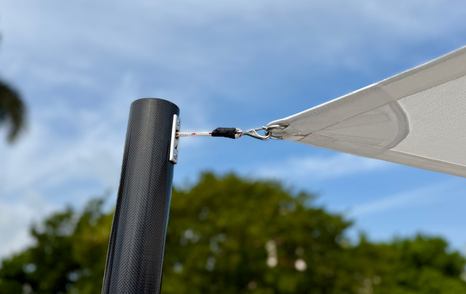

Below, this PC60 carries the optional on-deck owner’s cabin, pushing three further cabins into the hulls. It’s a smart layout for long stays aboard, giving the main deck a more open feel while still providing private spaces for guests or family. Finishes throughout are tailored by Horizon’s in-house team, with a mix of natural tones, custom joinery, and textured surfaces across the galley, saloon, and cabins. There’s enough scope to make each one feel distinct, while sticking to a solid and well-proven structure beneath.
The flybridge layout has been adjusted to fit the new through-access. The twin helm seats and helm console now sit slightly to port, leaving room for a passenger bench opposite and a straight shot through the centreline. This version includes a day head on this level too, making it practical for daytime use without needing to head below.
Also fitted as standard is Horizon’s Silent Living package. Paired with Victron lithium batteries and Termodinamica’s efficient climate system, it allows the yacht to stay cool and powered for close to 20 hours without touching the generator. That shift in systems design is a key part of how Horizon approaches long-range living aboard - not just about extending cruising time, but about improving comfort at anchor too.
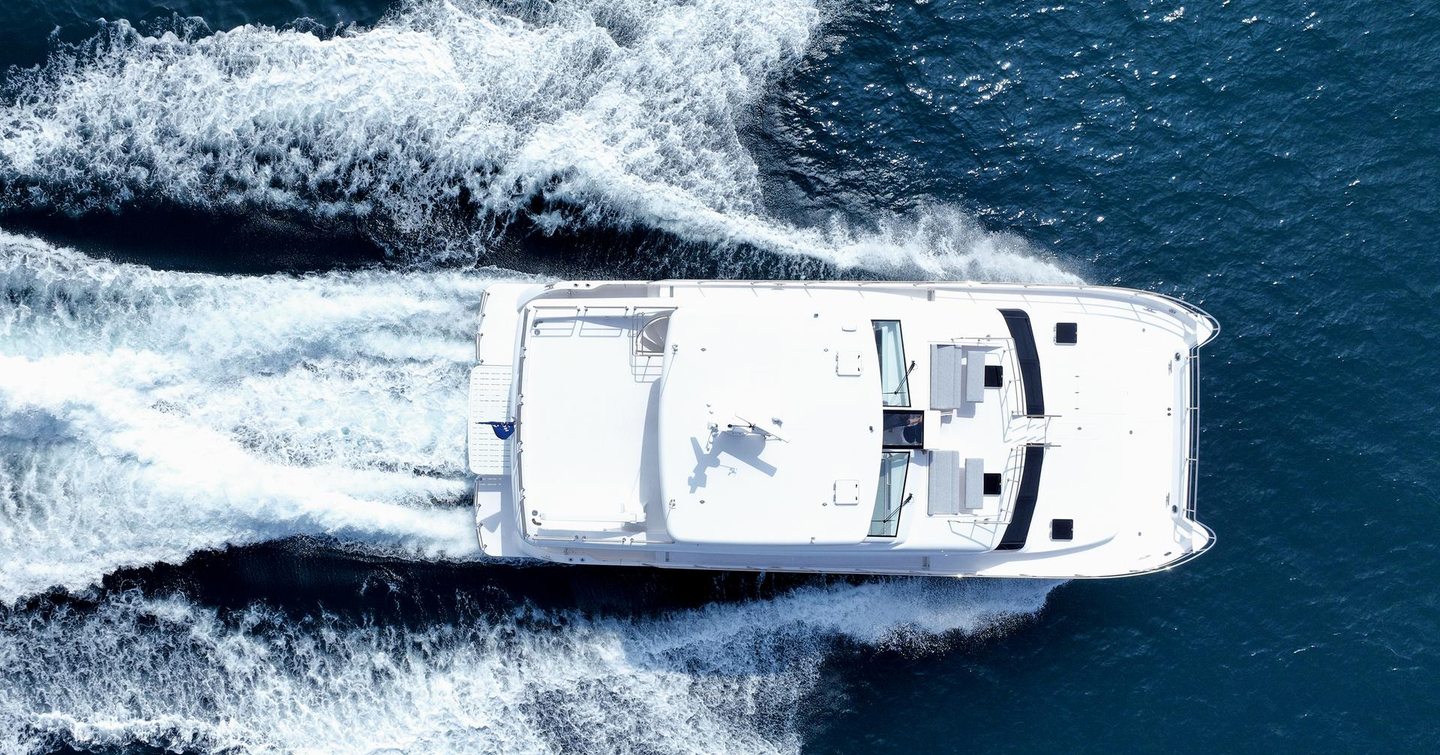
There’s a really warm, homely feel to the main saloon. The galley sits to starboard, and it’s a big one - loads of countertop space and a proper breakfast bar with bar stools. Just aft, there’s a good amount of cooling - full-height fridge door, freezer drawers, the lot. Cooking’s taken care of with an induction hob over to port. This is the only galley layout available on this model - there’s no option for a lower galley - but you can spec a forward dining area.

The internal dinette is another well-finished space. The table raises and lowers, with built-in seating opposite, and the TV mounted up on the wall ties it all together as a proper living area. There’s something very relaxed about it - almost apartment-like. As the Americans might say, it’s got a bit of a condo vibe. A boat that feels liveable, with a setup that would suit longer stays on board.
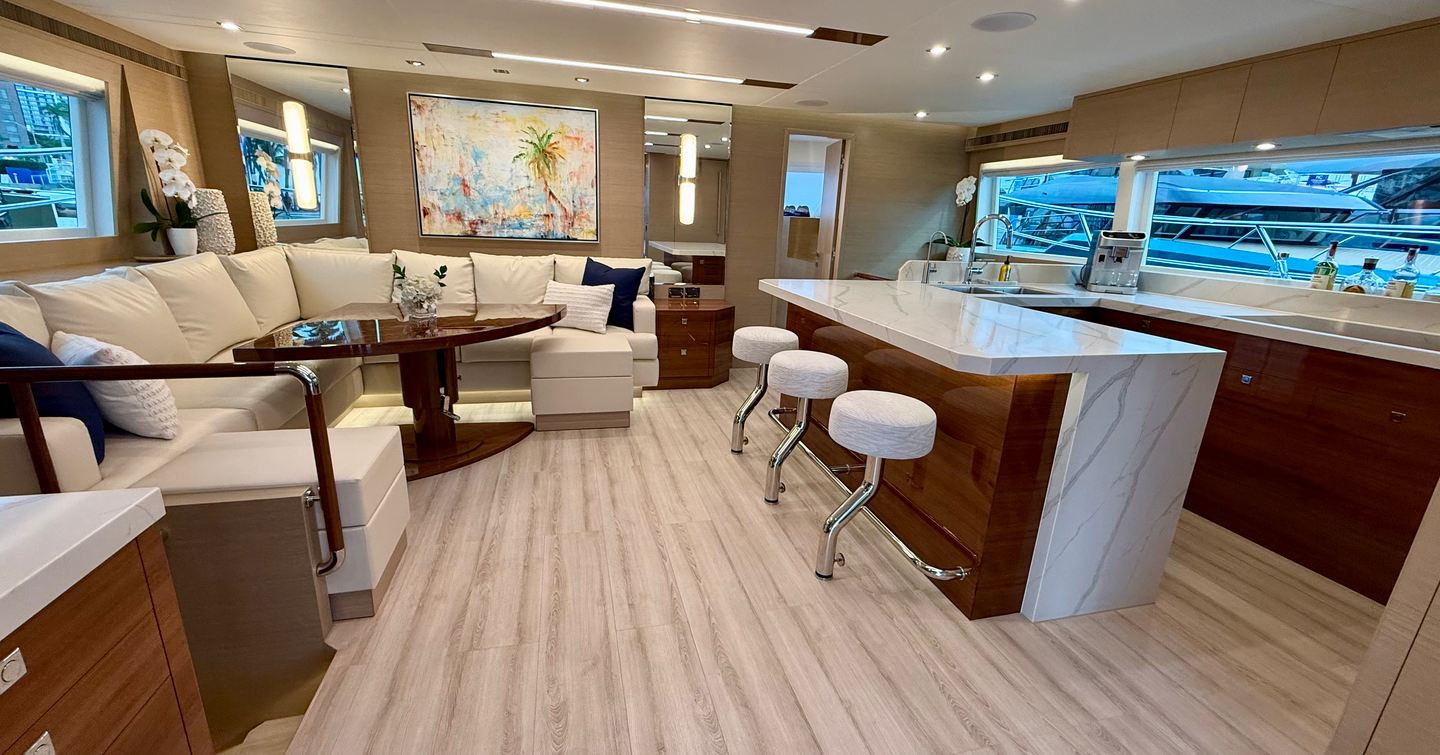

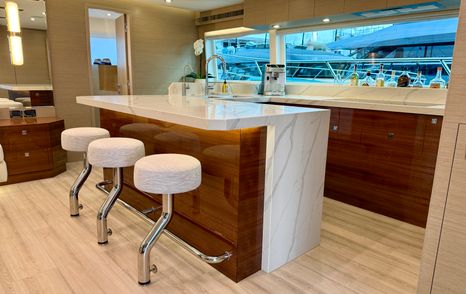
Owner's Cabin
This space is flexible. If you’d rather have it as a dinette or extended living area, that bulkhead can come out, opening it up into a larger dining space for more of a country kitchen feel. But as it stands, configured as the owner’s suite, it works beautifully.
It’s nearly full beam - the side decks take a little from the width, but not much - and there’s a proper island berth, fully walk-around, totally flat floor, and loads of headroom. The windows on either side bring in masses of natural light, and both have blinds for privacy when needed. Finishes here are nicely handled too - mostly gloss oak, but broken up with a walnut burst through the middle, which adds just the right bit of contrast. It's a bright, comfortable, and well-resolved space for the owner.

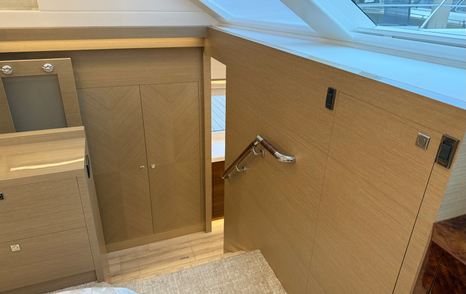
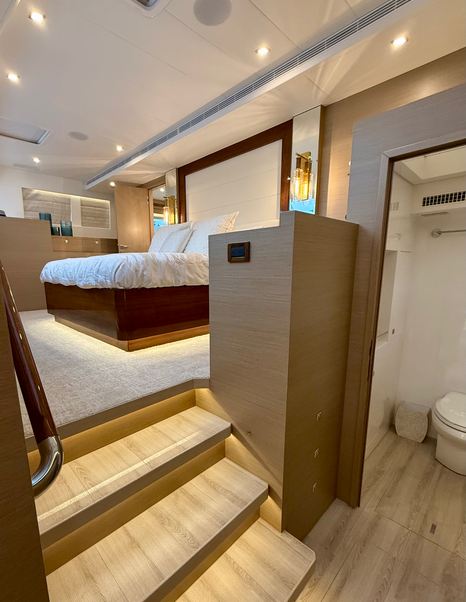
Down the run of steps on the port side is the owner’s bathroom, and it’s a clever bit of design. Loads of hanging storage greets you at the bottom of the stairs, followed by a split arrangement with the toilet compartment tucked aft and the main bathroom space forward, stretching out toward the forepeak.
The bathroom itself is bright and welcoming, thanks to a generous hull window and a skylight overhead, which also helps vent steam when the shower’s in use. The shower cubicle is fully enclosed, nicely finished, and features subtle touches like tiling inside the shelving to break up the otherwise clean white palette.
There’s even space here for twin sinks, which is no small feat given the boat’s size. This whole suite feels impressively spacious and well put together, especially considering the yacht comes in at just 18m (60ft). It’s a proper owner’s space, and a well-executed one at that.
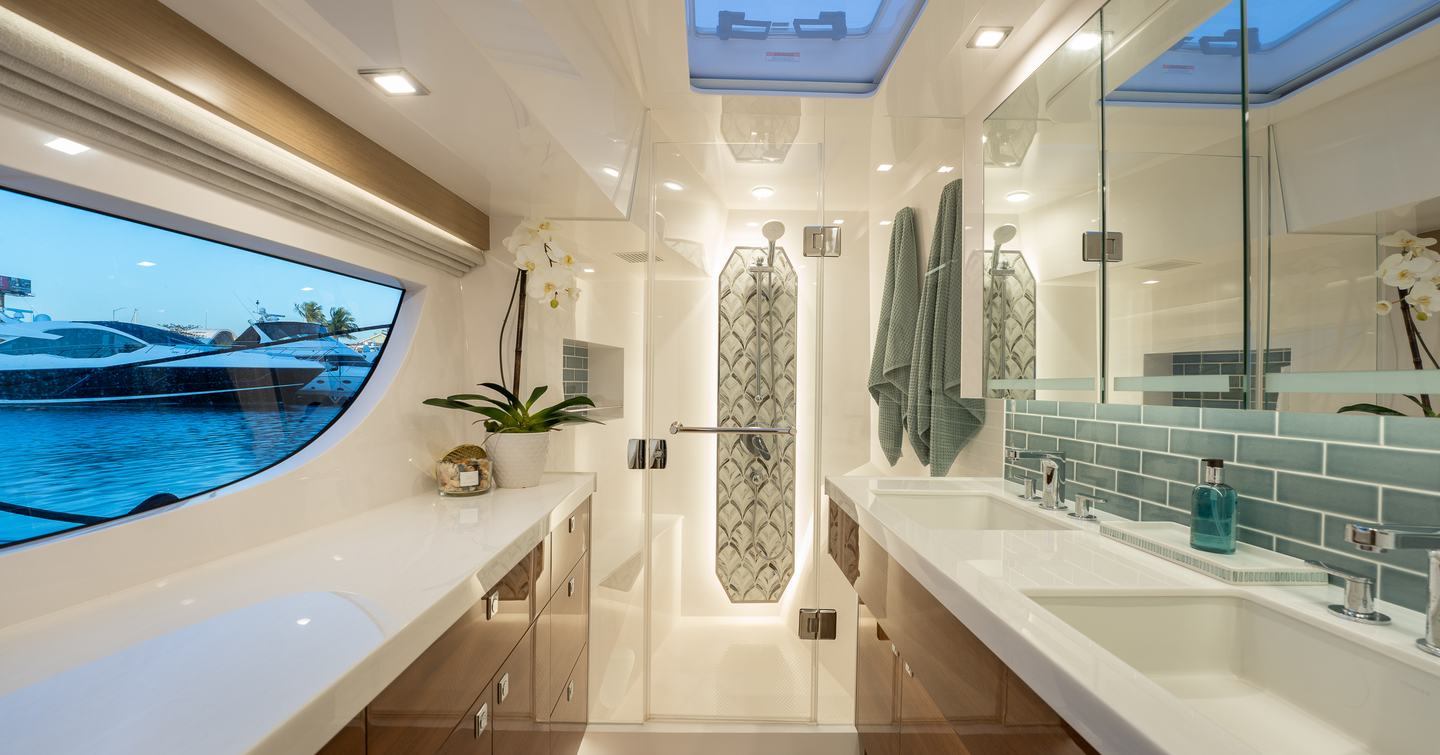
Guest Accommodation
If you opt for the main deck living area rather than the main deck master, then this forward space on the lower deck becomes the owner's cabin. In this layout, though, it serves as a very well-appointed VIP suite. Gone are the days of catamarans with beds pushed right into the bow - here, the double lies across the hull, giving proper walkaround access and a much better view out of the hull windows. Overhead hatches let in plenty of natural light, and when conditions allow, there’s enough through-flow for natural ventilation - though of course, full air conditioning runs throughout the boat.
This cabin includes a television and a very nicely done en suite. The smoked glass partition is a smart choice - rather than closing off the space with a solid panel, it keeps things feeling open and light. The en suite itself is a bit narrow, but you still get a separate shower cubicle, and the woodwork beneath the sink adds a level of finish that lifts the whole space. There’s an opening porthole in here, too - helpful for clearing steam without relying solely on the extractor.
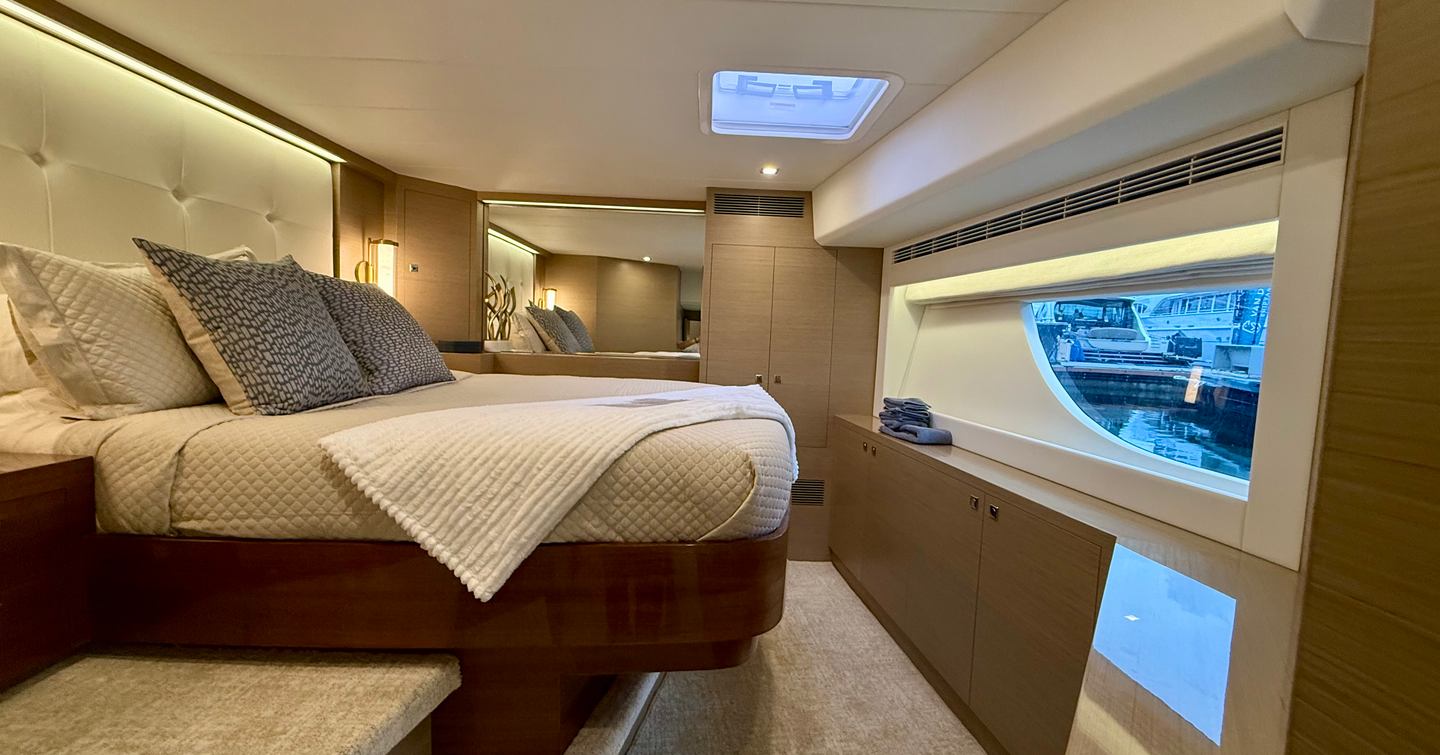
Aft of a laundry area is a twin cabin. It’s not en suite, so less suited to guests but ideal for children, occasional visitors, or possibly crew if the boat is being run that way. Storage is decent, with both hanging and drawer space, but without a private bathroom, it shares with the VIP suite forward.
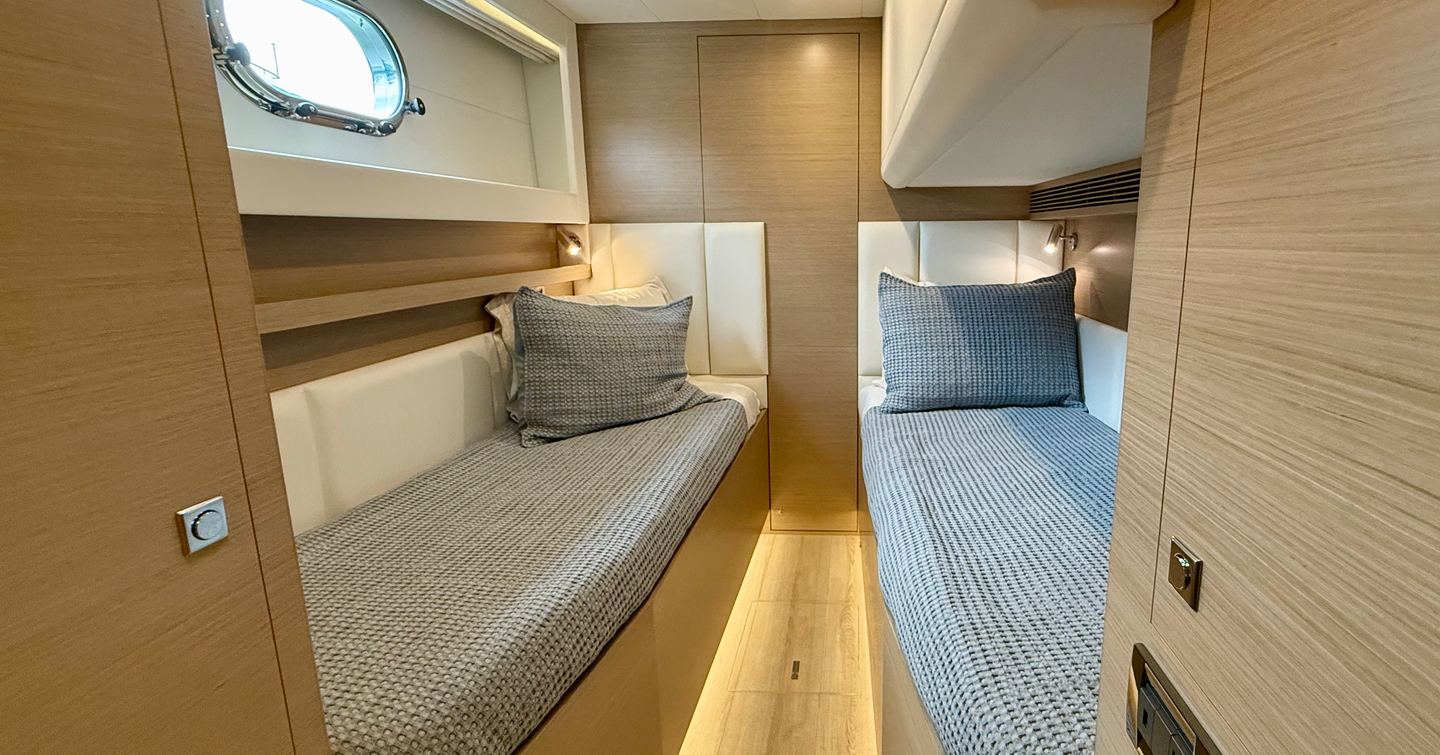
In the portside hull, there’s no galley-down arrangement here so the main variation is whether the main deck holds a master cabin or a living space. Forward in this hull is another twin cabin, and it’s a step up from the one opposite. Comfortable layout, good storage tucked behind the door, and solid headroom throughout.
There’s a small lobby area here, and this cabin does have a private en suite. It also works as the day head for the lower level - it’s the most accessible bathroom from the main deck, aside from the one up on the top deck, so it doubles up nicely when guests are onboard.
The split walk-through door forward of the upper saloon is what takes you out to the foredeck - a neat bit of design that keeps the flow of the boat feeling natural and connected.
The helm station up here is something else. It's seriously well executed. The helm features a clean, sharp arrangement of triple Garmin screens - one dedicated to the cockpit camera, giving you a clear view aft when you're manoeuvring from this position. The other two handle navigation and engine data, with plenty of flexibility in how they're laid out.
The steering wheel is a highlight in its own right - a Horizon spokeless stainless steel wheel that looks fantastic and feels just as good in hand. Seating is covered by a pair of Horizon-branded Stid adjustable chairs, properly sorted for longer passages. Comfortable, supportive, and chosen with serious cruising in mind.
This is the only helm on board, so it had to be right - and it is.

Over on the starboard side, the seating is arranged as a day bed at the moment, perfect for stretching out. Remove the cushion, and it becomes a wide, forward-facing bench - easily enough space for two or three people to join the skipper and enjoy the ride.

The big change on this model is the addition of a Portuguese bridge. It’s the first in the range to have one. Before, this whole area was pretty much dead space - no access, no seating, no door - and now it completely changes how the boat functions.
On the foredeck, there’s plenty of surface area - this is a power cat, after all, so the beam is generous. It’s a bright, open space. This particular boat has no teak or synthetic decking, which keeps it cool underfoot, though in strong sun, there’s no getting around the glare from all that white.



There’s a hatch in the deck - one in each forepeak - and these are proper deck lockers, big enough for fenders, lines, covers, and all the usual bits of kit. But lift the hatch, and it goes much further than that - this is effectively walk-in storage.
You’ve got clips up top holding the boat hook and paddle board paddle, and below that, space for dive tanks, fishing rods - the lot. There’s even a freshwater washdown fitted up here, so you can rinse the area off without having to run a hose up from the quayside every time.
As for lounging space, there are no fixed sun pads. Instead, they’ve gone with bean bags, which feels a bit more relaxed - and crucially, there’s room to stow them properly. Loose furnishings are no issue at all when there's this amount of storage.
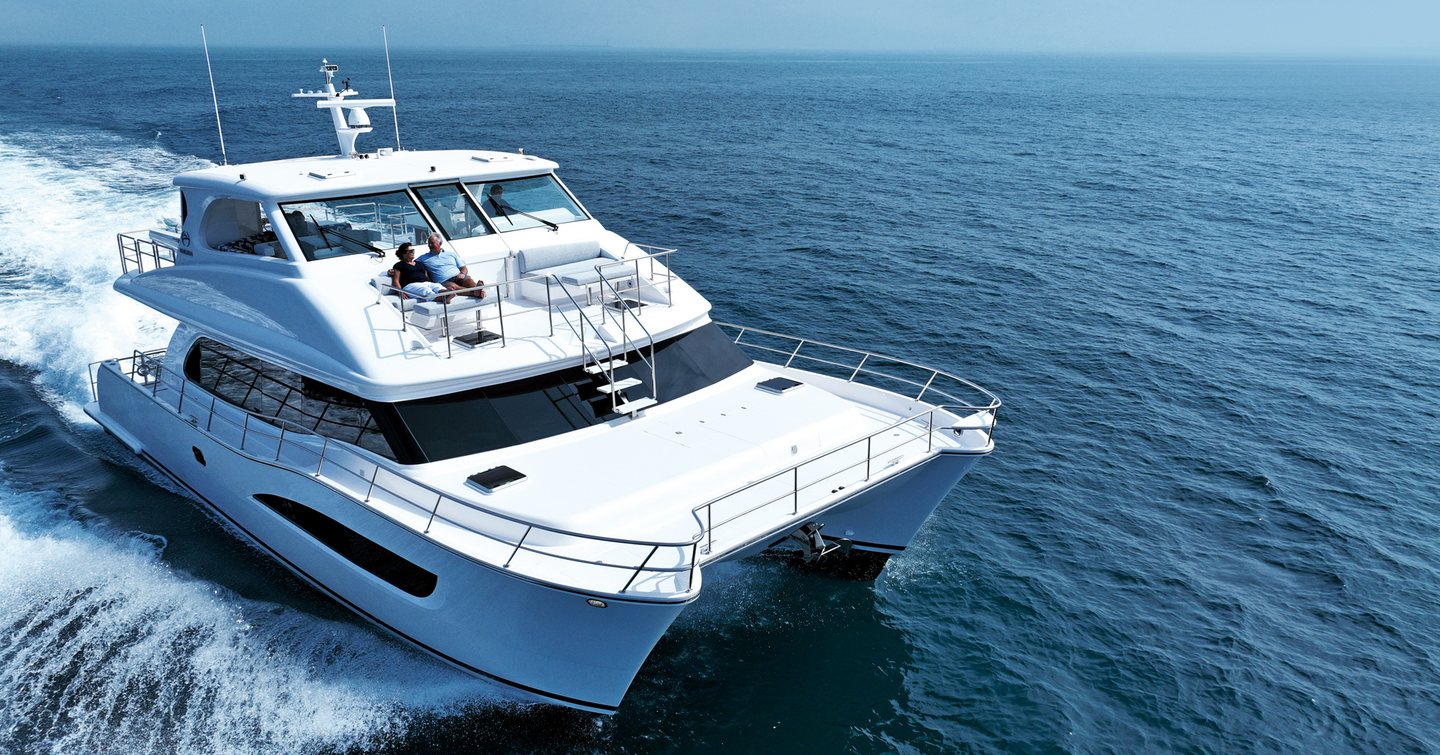
That staircase running straight up the centre of the foredeck is a smart bit of design. With just the one helm up top, it gives a direct route down to the bow - ideal if you're helping out with lines while also handling the boat. Step away from the helm, down those stairs, and you're right where you need to be.
But it’s not just practical. This space doubles as a social spot, especially when cruising at slower speeds. It’s a brilliant place to settle in, enjoy the motion, and take in the view ahead. When the boat's stationary, it still earns its keep - the cushions sit on top of tables, so you can strip them back and repurpose the whole setup for drinks or casual dining. It’s a clever use of space that works just as well underway as it does at anchor.
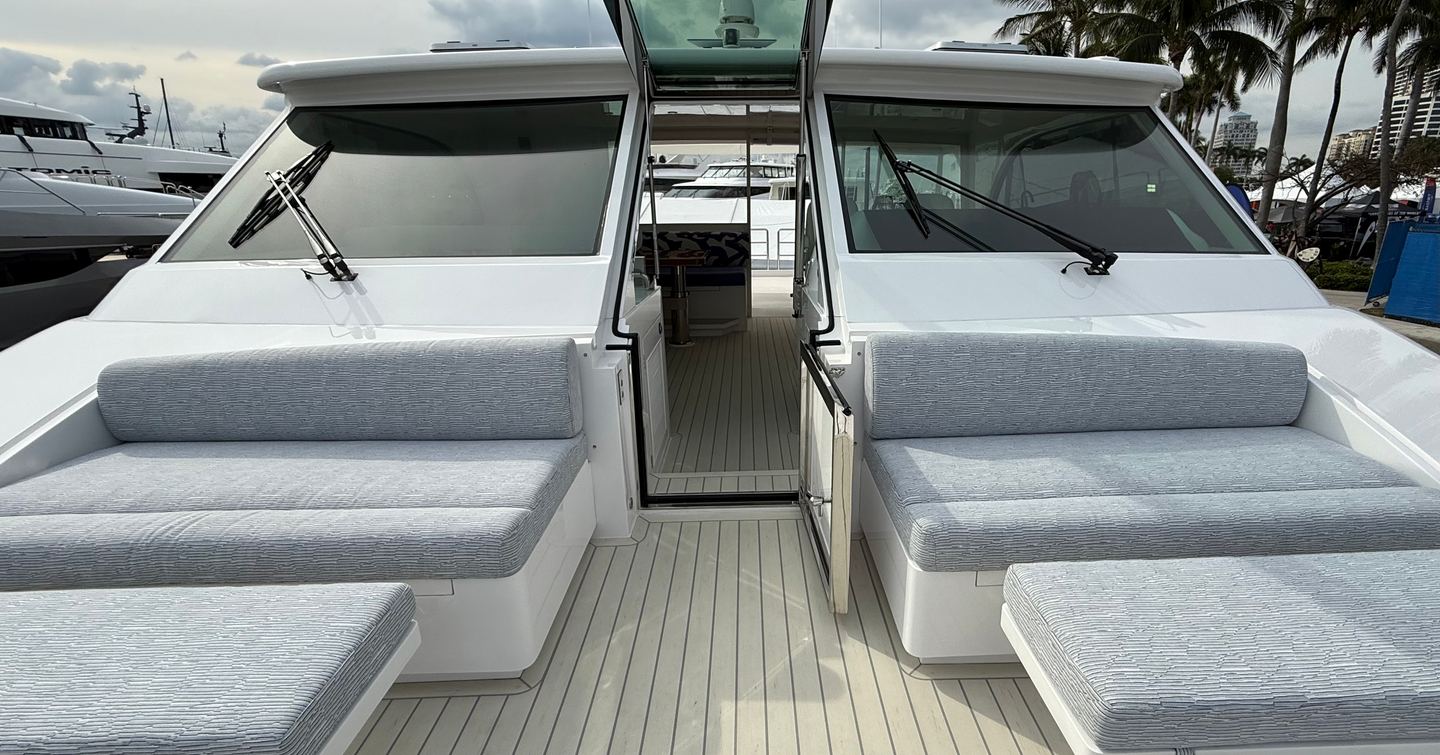
Side Decks
The side decks aren’t especially wide by power cat standards. They’re broad enough, just not dramatically wider than what you’d find on an 18m (60ft) monohull. That’s intentional. A lot of the beam has been given over to the saloon, rather than letting the side decks eat into the interior volume. After all, the appeal of a catamaran is that extra living space - no point giving it up to walkways.
That said, the side decks still work well. They’re practical in this layout, with boarding gates built in - small cutouts to allow side access when needed. There are also steps from the cockpit, so movement around the boat stays straightforward without compromising the main living areas.
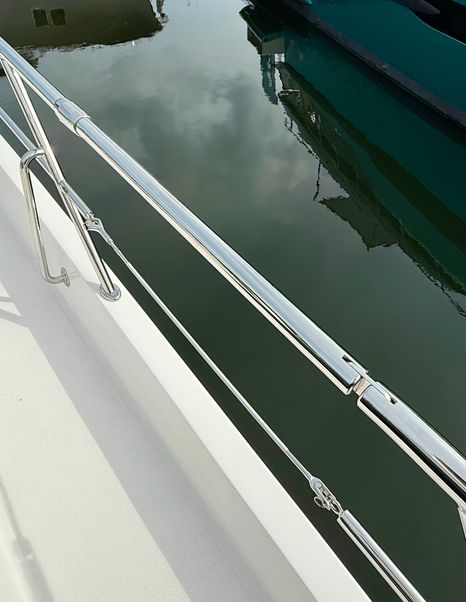
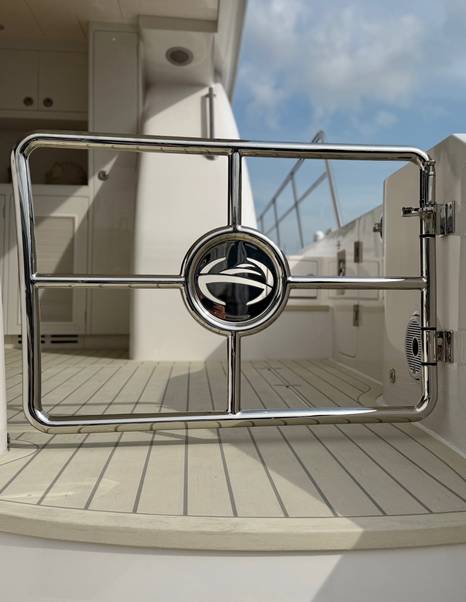
Cockpit
Catamarans, of course, split their hulls across two platforms - but here, they’re joined by a central platform that raises and lowers. It’s not intended for a large tender, though something like a Sea-Doo Spark would sit comfortably on it. Handy if you're looking to carry a mix of toys - with tender storage up top and a Jet Ski tucked in below, the layout makes good use of available space.
Over to port, there’s a fish prep station with a couple of rod holders set right aft - a nice touch for anyone wanting to drop a line in. Access into the cockpit is wide and open, and it’s well-shaded too. If guests want to eat outside during the day, this is likely where they’ll gravitate to. A canopy stretches over the transom, offering both protection and privacy. The layout is flexible as well - a separate sofa and dinette give the space structure without locking you into a fixed arrangement, since the table isn’t built into the transom itself.
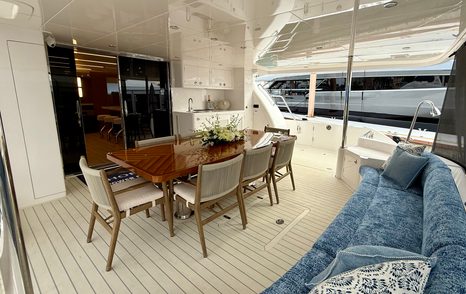
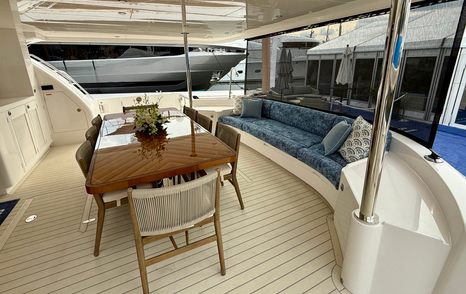

Flybridge
Just behind the helm station is a neatly designed dinette with a manual ratchet system from Horizon to raise and lower the table - a simple, practical setup. The high-gloss woodwork on the tabletop stands out, adding a bit of polish to what is a very functional space. Opposite sits the bar area, finished with a mix of white surfaces and inset wood detailing. It’s fitted with the basics you'd expect for serving on this level - a sink, ice maker, and fridge - so it’s ready to support a bit of hosting without needing to head below.
This whole area ties in aft, and although it can be fully enclosed with covers, it opens right out when needed, keeping everything well connected across the deck.

It also doubles as the tender deck, which explains the more open layout. Loose furniture can be added, but it’s designed to be kept clear for launch and retrieval. A crane handles lifting the tender onto its deck-mounted chocks.
One particularly useful touch is the day head - no need to head downstairs if you’re up here for a while. And there’s also a large chest freezer, giving this deck plenty of cold storage, especially handy with the main galley located one level down.
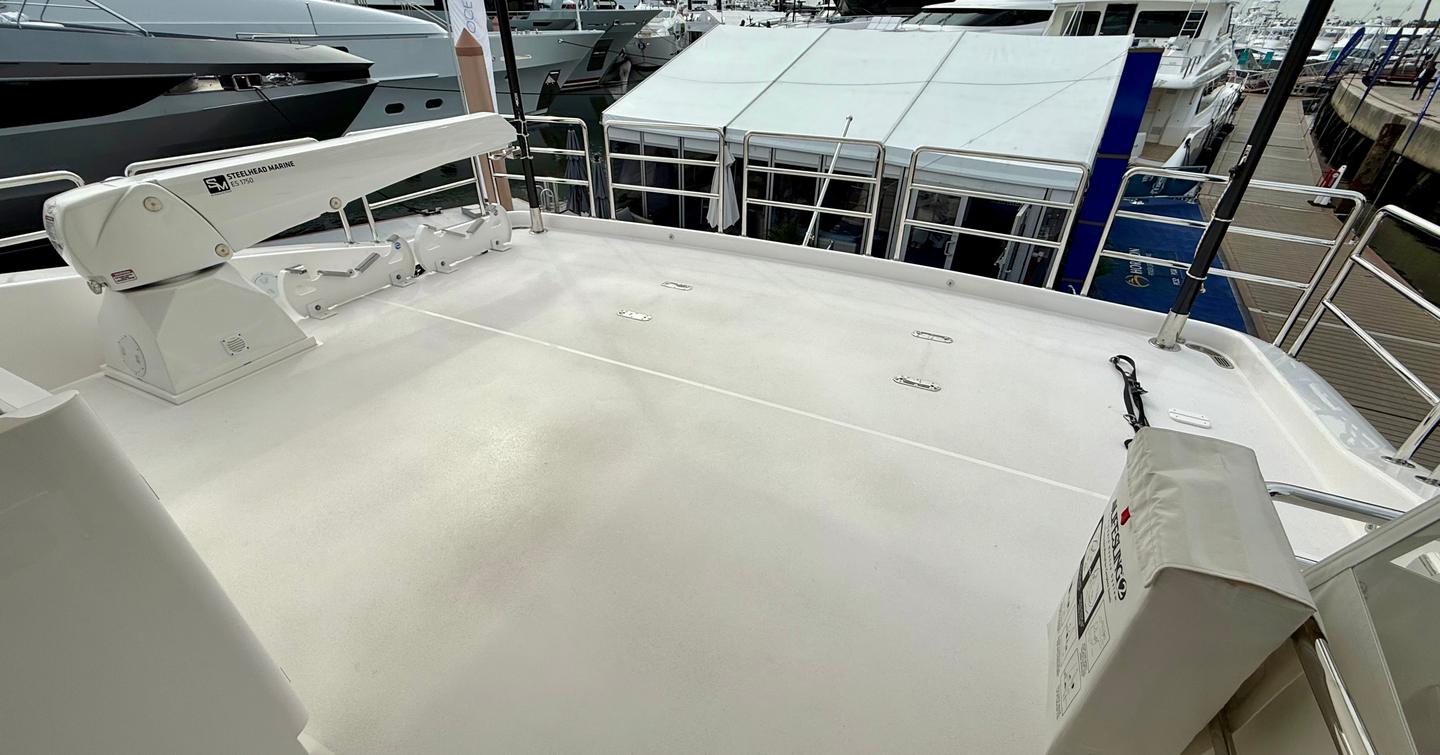
Being a catamaran, it's a split engine room setup - one in each hull. They're near-identical, so the focus here is on the starboard side. The hatches are seriously heavy - those rams are doing a proper shift each time you open them - but once they’re up, access is excellent. There’s a T-ladder fixed in place, making it straightforward to climb down into the space.
Fitted here are MAN engines, which at flat-out, you're looking at a top speed somewhere in the region of 20-25 knots, with a comfortable fast cruise at 18 knots, and over 1,000nm of range at displacement speeds.
Each engine has a hull to itself, which means there’s loads of room to move around. Forward of the engine is a bit tighter - that's where the shaft runs - but it’s still accessible, and importantly, everything that needs regular checks is easy to reach. Directly underfoot, you’ve got twin Racor fuel filters with clear bowls, so you can visually check for water or sediment, and if one clogs, you can switch to the other without fuss.
There’s no stabilisation system here - not needed on a cat - so this compartment is clean and uncluttered. It’s a layout that suits owner-operators well. If you’re doing your own maintenance, engine access like this makes all the difference. One of the perks of a catamaran - the engines have plenty of room.
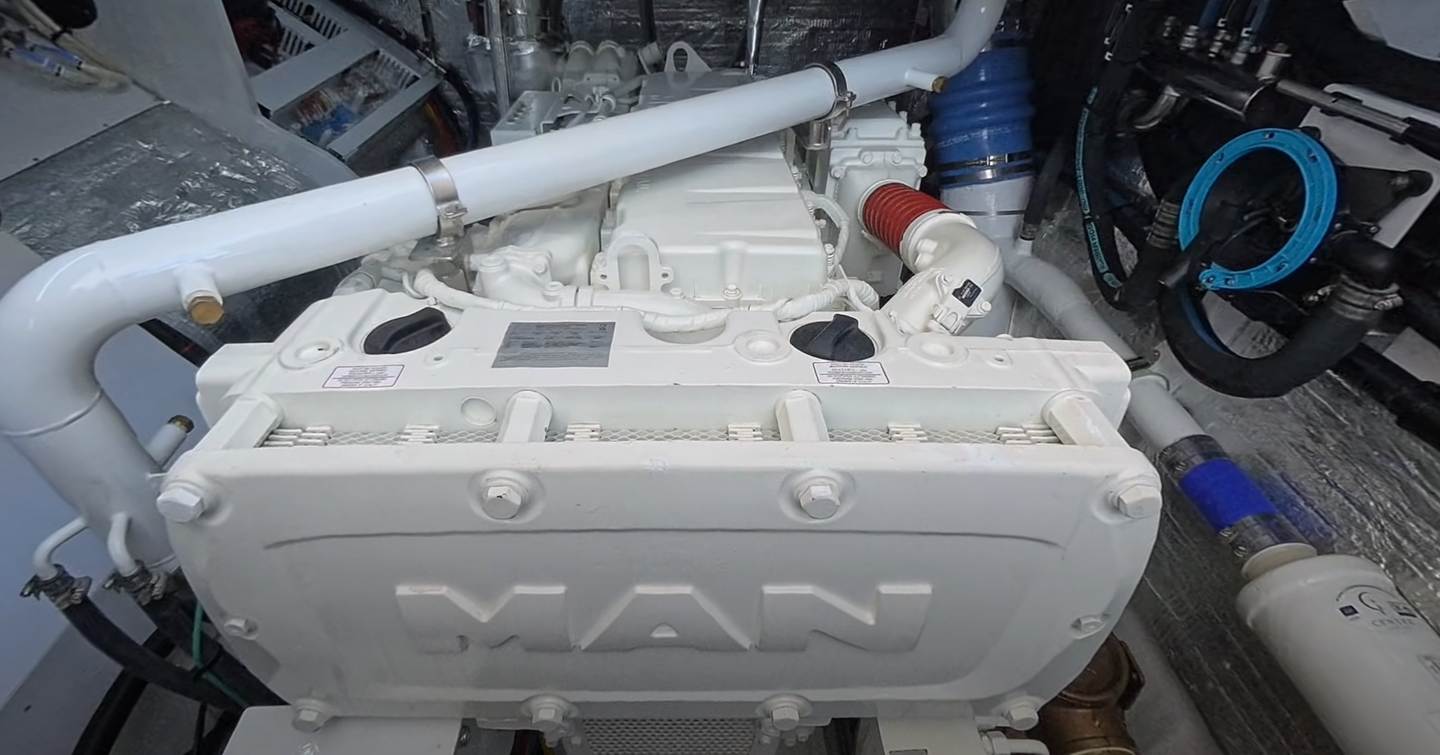
Our Verdict
The Horizon PC60 feels like a properly built multihull. They’ve had this model in the lineup for a long time without the Portuguese bridge, and it shows - the design hangs together very well. Everything works as it should, and as a platform for living on board, it just makes a lot of sense. The Portuguese bridge only adds to what is a very convincing formula, and one of the key factors of the PC60's appeal is that it's a multihull that is built like a luxury monohull. It doesn't feel built for charter, it doesn't feel 'wipe clean' and easy to hose down after a charter, it's a quality product that is now better than ever.
Reasons to Buy
- Portuguese bridge adds functionality
- Wide saloon with good headroom
- Big liveaboard potential
- Excellent deck storage
Things to Consider
- No galley-down option
- Bright foredeck - could cause glare
- Traditional styling
Looking to own a Horizon PC60? Use YachtBuyer’s Market Watch to compare all new and used Horizon PC60 Catamarans for sale worldwide. You can also order a new Horizon PC60, customized to your exact specifications, with options for engine choice and layout configuration. Alternatively, explore our global listings of new and used catamarans for sale and find your perfect catamaran today!
Rivals to Consider
The Horizon PC60 offers a solid package for owners cruising with smaller groups. It sleeps six in three cabins and gives you a generous on-deck master with hull-side windows and en-suite. The Sunreef 60 Power Eco, on the other hand, is all about capacity, quiet running, and solar panels. It can take up to twelve guests across six cabins, and its solar skin covering up to 68.6m² lets you run near-silent on electric power for long stretches. If you’re after bigger guest numbers and green credentials, the Sunreef is a serious contender.
The PC60 cruises comfortably at 18 knots and tops out around 27 knots with twin 850hp MAN i6-850s, so it’s well suited to covering distance at a decent lick. The Silent 62 Fly runs fully on solar-electric power with a cruising speed around 6-8 knots and a peak up to 15 knots, but the real attraction is its near-silent running and very low operating costs. It’ll sleep up to twelve in six cabins, so it’s a better choice if you regularly cruise with a big group and like the idea of quiet passages.
The PC60 is a classic long-distance cruising cat with a proper separation between inside and out, and cabins that give you good privacy. The Silent 62 Open has connected deck spaces and a more free-flowing social layout. It sleeps up to eight guests in four cabins, and it shares the same fully solar-electric setup as its Flybridge sister - low speeds, minimal noise, and long-range potential without touching the fuel tanks. If you like your cruising more casual and social, with everyone out on deck together, the 62 Open has that nailed.
If you’re mostly cruising in settled weather, the PC60’s mix of flybridge living and bright, open interiors will suit you well. If you want year-round flexibility, the Silent 62 Closed gives you a fully enclosed main deck with climate control and proper protection from the elements. It shares the same solar-electric propulsion as the other Silent models, cruising around 6-8 knots with a top speed up to 15 knots. The PC60 is the faster boat by some margin, but the Silent 62 Closed is a strong option if you want a self-sufficient cruiser with a protected helm and living space.
The PC60 is a fast, comfortable powercat for island-hopping or coastal cruising - 18-knot cruising, 27 knots flat out, easy to handle, with good private accommodation. The Bering BC60 is a different beast altogether. It’s built for long-haul passages with a 3,000-nautical-mile range, a displacement steel hull, and an ocean-capable profile. It cruises at around 8-10 knots but is built to just keep going. If you want to get places quickly and enjoy marina life along the way, the PC60 fits the bill. If you’re more about self-sufficiency and serious miles under the keel, the BC60 is the tougher, long-legged option.
Considering a new catamaran? Explore Horizon's entire current range to find the model that best suits your needs, and compare it with alternatives from competitors to ensure you make the perfect choice.
Specifications
- Builder Horizon
- Range PC Series
- Model PC60
- Length Overall 18.88m
- Beam 7.47m
- Draft 1.66m
- Hull GRP
- Cabins 4
- Berths 8
- Crew 2
- Cruising Speed
- Max Speed
- Fuel Capacity 3,785 Litres
- Fresh Water Capacity 945 Litres
- Engine Model 2x MAN i6-850
- Engine economic speed 9 knots
- Engine max range (speed type) 1200 (nm)
Interested in a PC60?
NEW Build
Find your local dealer for a personalised, no-cost consultation
or just request
Brochures & Pricing
Used & In Stock
Looking for a ready-to-go PC60 or pre-owned options? Explore all inventory of the PC60 available worldwide
